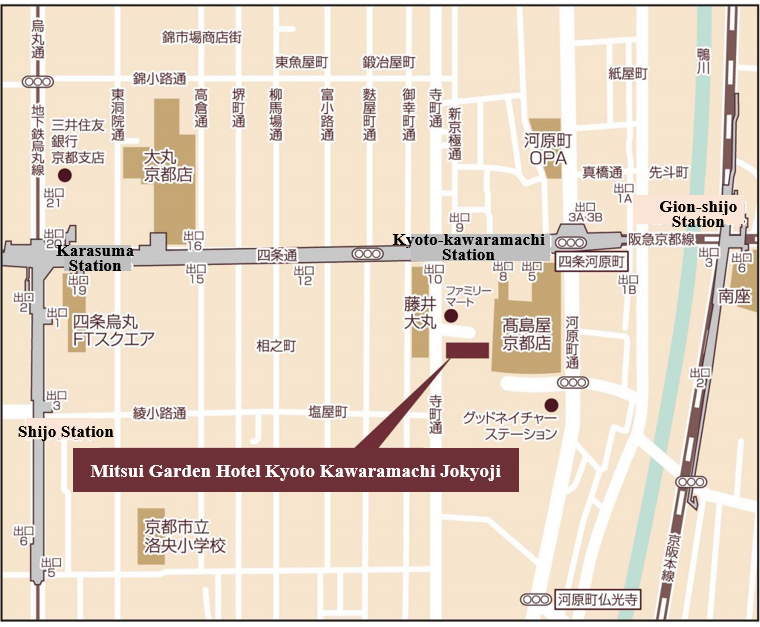A Hotel in Harmony with a Temple Appears in Kyoto’s Kawaramachi,
Its Highlight Being a View of the Main Hall from the Lobby
Mitsui Garden Hotel Kyoto Kawaramachi Jokyoji Opens September 28, 2020
New Model Case Regenerating a Temple to Carry on the Historical Place of
Worship for Future Generations
September 15, 2020
Mitsui Fudosan Co., Ltd.
Mitsui Fudosan Hotel Management Co., Ltd.
Tokyo, Japan, September 15, 2020 - Mitsui Fudosan Co., Ltd., a leading global real estate company headquartered in Tokyo, and Mitsui Fudosan Hotel Management Co., Ltd. announced today that Mitsui Garden Hotel Kyoto Kawaramachi Jokyoji (167 guest rooms) will open on Monday, September 28, 2020.
This hotel is located on Teramachi-dori, known as a repository of historical sites and venerated stores, and has outstanding access to public transportation, being approx. 1 minutes’ walk from Kyoto-kawaramachi Station on the Hankyu Kyoto Main Line. The location also makes it highly convenient as a base for sightseeing in Kyoto, being within walking distance of areas that bustle day and night, such as Shijokawaramachi, Pontocho and Gion. This is an integrated temple and hotel development with Tamonzan Torodo Jokyoji Temple that makes it an innovative multi-use building of a type not seen elsewhere, and fulfills a social mission of carrying on a historical temple for future generations. The development integrating with a hotel aims to become a new model case for regenerating temples as is a method for resolving a social issue faced by many temples.
Under the hotel concept of “a temple hotel for future generations,” treated pillars of old wood with a black and white tone and decorations derived from Jokyoji Temple are positioned throughout, and the design reminiscent of a temple creates an elegant and quiet space evoking thoughts of an art gallery. Experiences that can only be had in this hotel in collaboration with Jokyoji Temple are also in the works, such as a morning Buddhist prayer experience.
Guest rooms are spacious, all capable of accommodating two or more guests and there are also triple rooms good for group journeys. Lighting in the rooms captures the motif of lanterns, a symbol of Jokyoji Temple, and the design throughout evokes images of a temple visit.
Restaurant SANGA ONO KYOTO JOKYOJI will be opened on 2F by the ONO GROUP, which has developed numerous dining businesses in Fukuoka Prefecture. This will be the second SANGA ONO restaurant following on from SANGA ONO ISSHUAN, which has been listed in a Michelin guide and stands out for providing a Japanese cuisine banquet prepared with meticulous detail.
< Features of Mitsui Garden Hotel Kyoto >
- Highly convenient location as a sightseeing base, approx. 1 minutes’ walk from Kyoto-kawaramachi Station and within walking distance from Shijokawaramachi, Pontocho and Gion
- A hotel in harmony with a temple combines the tangible and intangible as the building is filled with decorations from Jokyoji Temple boasting of a 500-year history and enables the likes of a morning Buddhist prayer experience
- SANGA ONO KYOTO JOKYOJI, the first location of Fukuoka’s renowned and Michelin-listed SANGA ONO Japanese cuisine restaurant to open in a different prefecture
- Tamonzan Torodo Jokyoji Temple will raise the curtain on a new history through integrated development with a hotel
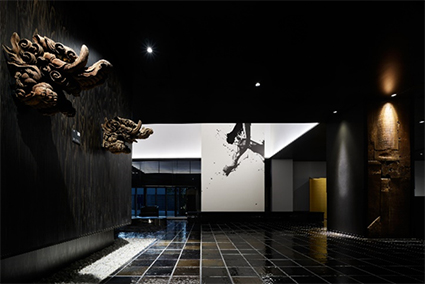
Lobby
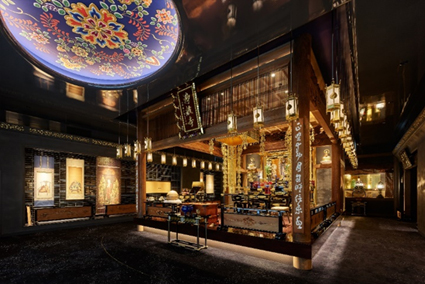
Jokyoji Temple’s main hall
■ Features of Mitsui Garden Hotel Kyoto Kawaramachi Jokyoji
1. Highly convenient location as a sightseeing base, approx. 1 minutes’ walk from Kyoto-kawaramachi Station
and within walking distance from Shijokawaramachi, Pontocho and Gion
This hotel has outstanding access to transport, being approx. 1 minutes’ walk from Kyoto-kawaramachi Station on the Hankyu Kyoto Main Line and approx. 7 minutes’ walk from Gion-shijo Station on the Keihan Main Line, and located on Teramachi-dori, lined with a treasure trove of historical sites and various venerated stores. The location also makes it highly convenient as a base for sightseeing in Kyoto, being within walking distance of areas that bustle day and night, such as Shijokawaramachi, Pontocho and Gion.
2. A hotel in harmony with a temple combines the tangible and intangible as the building is filled with decorations from Jokyoji Temple boasting of a 500-year history and enables the likes of a morning Buddhist prayer experience
(1) An Integrated Temple and Hotel Development with Social Significance
Kyoto has been closely tied to temples since the Heian Period (794-1185). There are numerous temples such as those well-known as sightseeing spots visited by many people from within and outside of Japan, and those relied on and loved by the people living in Kyoto. Meanwhile, many temples have been forced to close due to reasons such as aging facilities, lack of a successor or loss of financial supporters. To enable Jokyoji Temple to be passed on to future generations, Mitsui Fudosan planned a collaboration between a temple and hotel to create an innovative multi-use building. As a solution for social issues confronting many temples, integration with hotels aims to become a new model case for temple regeneration.
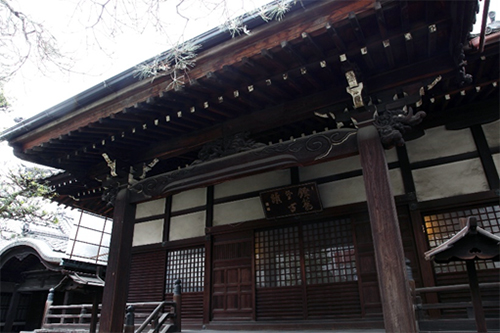
Jokyoji Temple’s main hall before reconstruction
(2) Hotel Concept of “A Temple Hotel for Future Generations”
As this is an extremely rare type of hotel integrating a temple to provide a stay that can only be experienced in this place, the concept of “a temple hotel for future generations” was established. The development gives form to the head priest’s wish to fulfill a mission to carry on the temple, the heart of Kyoto, and make it an intimate place. NIKKEN SPACE DESIGN LTD. carried out the interior design based on the overall concept of appreciating white spaces with no clutter. Therefore, meticulous attention was paid to creating spaces that bring out the building’s inherent beauty and white areas that evoke spaciousness, rather than using extravagant ornamentation.
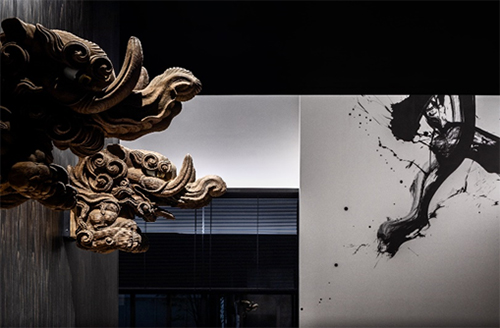
Hotel design under the concept of “a temple hotel for future generations”
(3) Landscape (Approach), Exterior and Entrance
Jokyoji Temple has existed on this site for a long time. The development takes a traditional facility that has carried on the temple’s history and given its landscape and exterior that makes it sublimely modern. A three-meter-tall lantern, a symbol of Jokyoji Temple, has been placed in front of the entrance. An approach of approx. 40 meters has been set up from Teramachi-dori, the road fronting the hotel, guiding guests from the tumult of the city to the silence of the temple and welcoming them to the hotel, main gate of the temple and temple grounds.
The exterior base has a two-stage rooftop canopy carrying on the traditional architectural design of Kyoto and reticulated curtain motif formed with rafters and eaves in a manner only capable of a temple. The development has created a typical, tasteful Kyoto landscape.
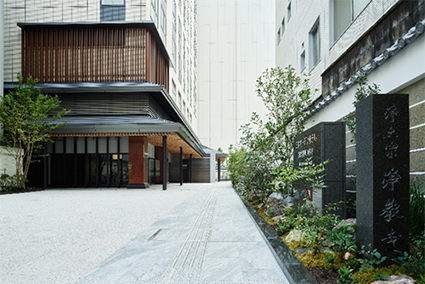
Hotel exterior seen from the approach
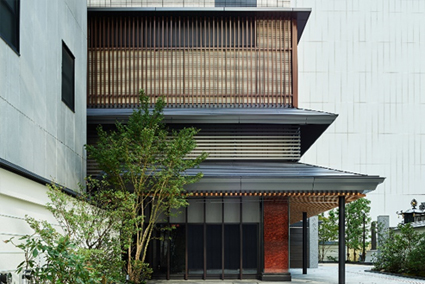
Exterior design (base)
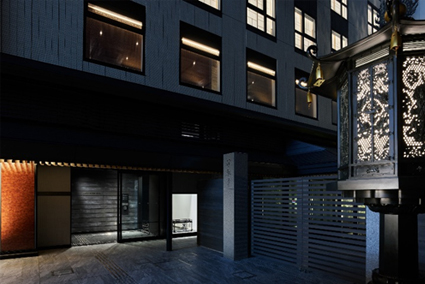
Entrance
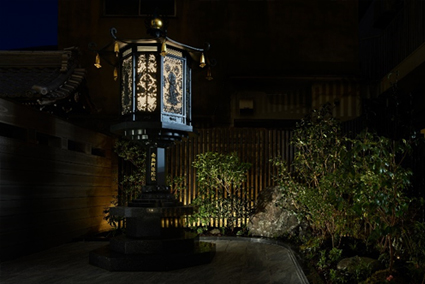
Lantern
(4) Lobby (1F)
Leaving the entrance brings guests to a spacious lobby with a height of approx. 7 meters and a two-level stairwell. Treated pillars of old wood with a black and white tone and decorations derived from Jokyoji Temple are positioned throughout, and the design reminiscent of a temple creates an elegant and quiet space evoking thoughts of an art gallery. Big Art painted by Gen Miyamura with a hair brush on a white wall faithfully expresses the interior design concept to appreciate white space and have a world without clutter. Moreover, the development has been fashioned to enable viewing the main hall from the hotel through small windows set up between the lobby and Jokyoji Temple.
* Cannot be used during Buddhist memorial services or events.
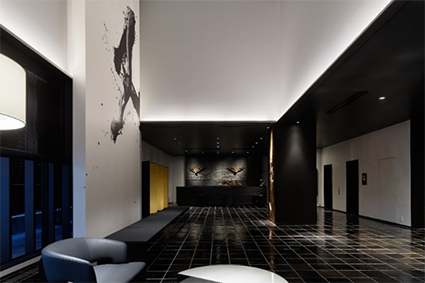
Lobby and reception desk
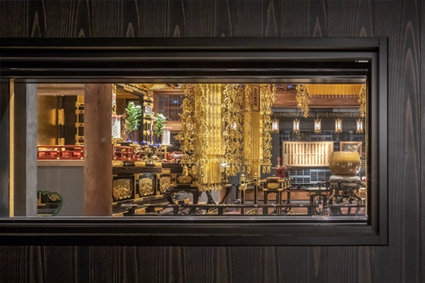
A small window provides a view of Jokyoji Temple’s main hall from the hotel
(5) Large bath (2F)
A washbasin object and wall art reminiscent of an ink painting in the background are in the large communal bath exclusively for guests, offering the feel of a temple even when taking a bath. By making other interior decorations black, the washbasin and artwork alone appear to be wondrously floating and give depth to the space to make it seem endless. Wall art has been depicted under the concepts of “impermanence” in the men’s large bath and “reincarnation” in the women’s large bath. The feelings of power of “impermanence” and gentleness of “reincarnation” are each incorporated in the depictions.
< Operating hours > 3:00 PM to 1:00 AM / 6:00 AM to 10:00 AM * For overnight guests only, free of charge
*Since opening, the number of people that may use the large public bath is partially limited as an infectious disease prevention measure. Depending on the situation going forward, the large bath’s operating hours may change, so please check the hotel’s website for the latest information.
https://www.gardenhotels.co.jp/kyoto-kawaramachi-jokyoji/eng/bath/
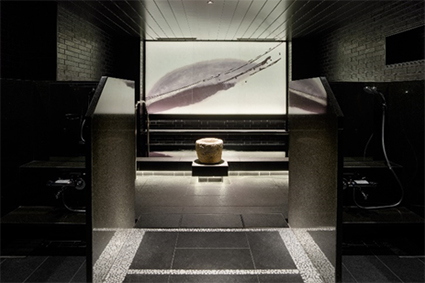
Men’s large bath
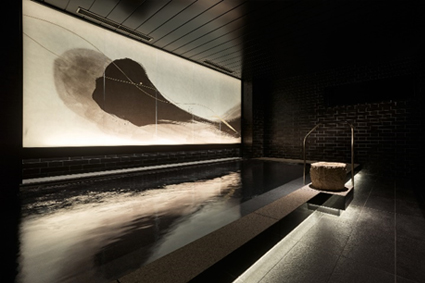
Women’s large bath
(6) Guest rooms (2F–9F)
Guest rooms are spacious, all capable of accommodating two or more guests. There are also triple rooms good for group journeys, and room types with tatami spaces to remove shoes and relax (Moderate Queen (Japanese)), enabling guests to choose the type of room based on how they’ll use it. The design incorporates the appeal of a temple with out-basin-style washbasins derived from the aforementioned washbasin and lighting using the motif of lanterns, a symbol of Jokyoji Temple. Completion of the large bath means that guest rooms are equipped with only shower facilities.
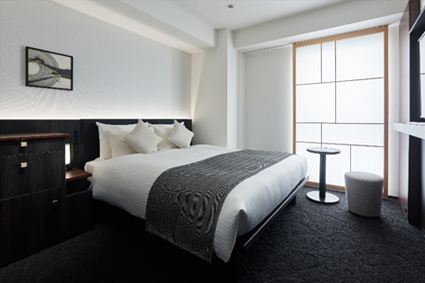
Guestroom (Moderate Queen)
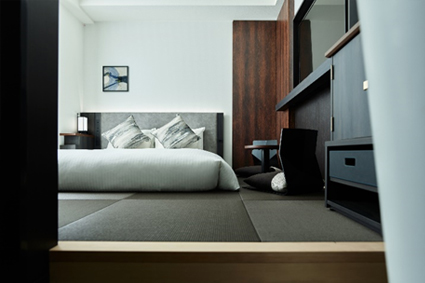
Guestroom (Moderate Queen (Japanese Style))
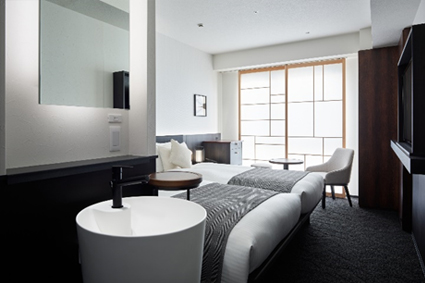
Guestroom (Moderate Twin)
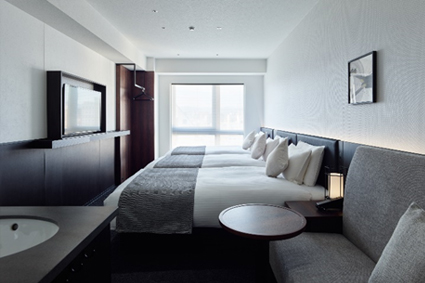
Guestroom (Triple)
< Guestroom composition >
| Room name | Size | Bed size | Guest capacity | Guest rooms |
|---|---|---|---|---|
| Moderate Queen | 19.0m2 | 1,640×1,970mm | 2 | 39 |
| Moderate Queen (Japanese Style) | 18.5 m2 | 1,640×1,970mm | 2 | 3 |
| Moderate Twin | 24.0 m2 | 1,110×1,970mm | 2 | 117 |
| Triple | 27.8 m2 | 1,110×1,970mm | 3 | 7 |
| Accessible Queen | 24.8 m2 | 1,640×1,970mm | 2 | 1 |
| Total 167 |
Maximum number of guests: 341
Check-in: 15:00 / Check-out: 11:00
(7) Artwork, Artifacts and Ornaments
In addition to the hair brush Big Art in the lobby, Jokyoji Temple’s artifacts and ornaments and historical artwork are also stored and displayed within the building.
<Description of (Some) Artwork, Artifacts and Ornaments>
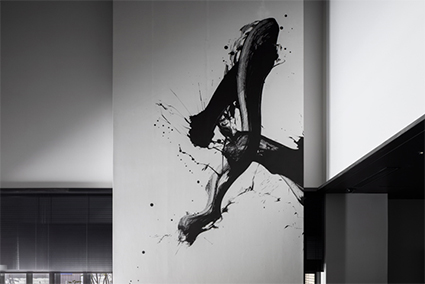
Writing brush Big Art Kuu (1F lobby)
Artwork by Gen Miyamura. Named Kuu to reflect the Buddhist proverb that says, “The world is constantly altered by fate. Nothing exists without change and all things change and transition.”。
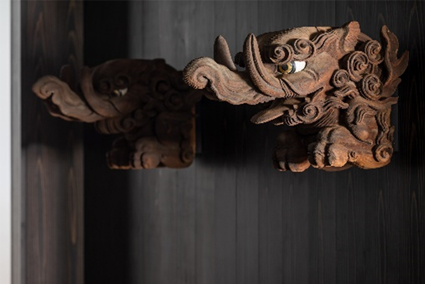
Architraves (1F lobby)
Before the rebuilding of Jokyoji Temple, these architraves had gone through the arched beams decorating the pillars of the main hall. They not only display the beauty of shrine and temple architecture, they are a cultural material that expresses an era, making them extremely valuable. These architraves were made in Bunsei 13 (1829).
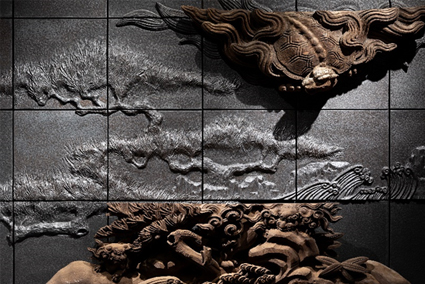
Arched beam decorations (1F reception area)
Decorations used before the rebuilding of Jokyoji Temple are combined with ceramic reliefs made by TOGAKUDO Co., Ltd. to form wall art. These wooden sculptures were made in Bunsei 13 (1829).
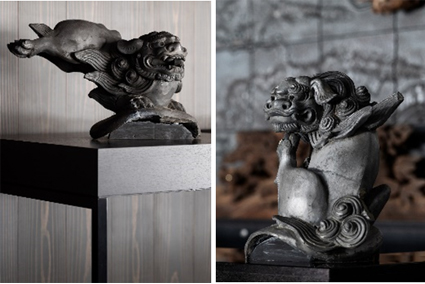
Lion-shaped roof tiles (1F reception and 2F elevator hall)
Roof tiles that had been used at the northern and southern ends of the main hall. The female lion with an opened mouth, called A, has been installed in the 2F elevator hall, and the male lion with a closed mouth, called Un, decorates 1F reception. The lions were made in Showa 10 (1935).
3. SANGA ONO KYOTO JOKYOJI, the first location of Fukuoka’s renowned and Michelin-listed SANGA ONO Japanese cuisine restaurant to open in a different prefecture
Restaurant SANGA ONO KYOTO JOKYOJI will be opened on 2F by the ONO GROUP, which operates numerous dining and other businesses in Fukuoka Prefecture, and will mark the second SANGA ONO restaurant following on from SANGA ONO ISSHUAN, which has been listed in a Michelin guide. Breakfast is offered in a plate format with a choice of four main dishes: Sanga chirashi zushi, eel with soft eggs, eel with steamed turnip or tempura and sea bream chazuke. This original Sanga chirashi zushi is a vegetable chirashi zushi expressing the world view of Jodo Buddhism, and is a dish for enjoying the colorful appearance and umami and depth of vegetables. Lunches include handmade soba noodles sourced directly from Akama Chaya Asago, a Michelin-listed restaurant. Dinners include suppon cuisine and courses using seasonal ingredients such as eel or conger eel meticulously prepared by a head chef who spent many years at the restaurant Kyoto Kitcho.
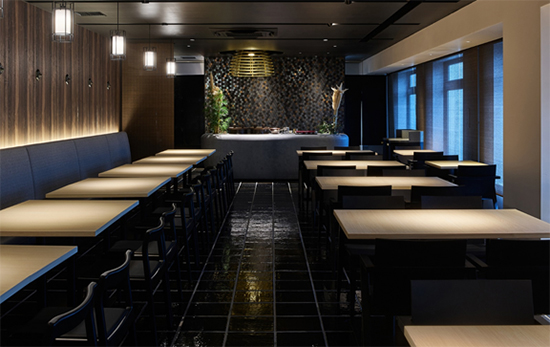
Restaurant (interior)
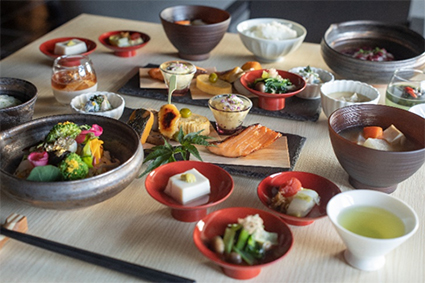
Breakfast
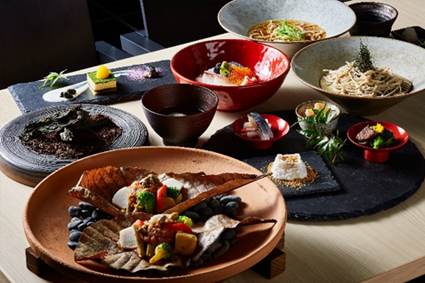
Dinner
< Overview of SANGA ONO KYOTO JOKYOJI >
| Operating hours | Breakfast 6:30~11:00 (Last entry 10:30) Lunch 11:00~15:30 (Last entry 14:30) Dinner 17:00~21:30 (Last entry 20:30) * Non-staying guests also use the restaurant * Operating hours are subject to change due to the impact of COVID-19 |
|---|---|
| Number of seats | 70 |
| Breakfast | Meals offered |
| TEL | 075-708-8868 |
| Notes | No smoking in the restaurant |
< Overview of the ONO GROUP >
| Company name | D.D. Company Ltd. (ONO GROUP) |
|---|---|
| Opening overview | SANGA ONO-KYOTO JOKYOJI |
| Business | Operation of restaurants |
| Location | Maizuru 1-3-5, Chuo-ku, Fukuoka, Fukuoka Prefecture |
| Representative | Takashi Ono |
| Official website | https://ono-group.com/ |
4. Tamonzan Torodo Jokyoji Temple will raise the curtain on a new history through integrated development with a hotel
Jokyoji Temple’s official name is Tamonzan Torodo Jokyoji Temple and it is a temple in Jodo Buddhism, which has its head temple at Chion-in, famous for its Sanmon main gate, a national treasure. The temple was founded in the Joan era (1171-1175) when Taira Shigemori, the eldest son of Taira clan leader Taira Kiyomori, constructed 48 temples within the grounds of Komatsudani in the Higashiyama area of Kyoto. The temple was known at the time as Higashiyama Torodo Hall (Higayashiyama lantern hall) and Shigemori’s faith was so strong he was called the “Lantern Minister.” In 1449, Emperor Go-Hanazono bestowed the “Jokyoji” name on the temple and it relocated to the Gojo Higashinotoin district of Kyoto before shifting to its current location in Teramachi-dori due to Toyotomi Hideyoshi’s 1591 rearrangement of shrines and temples within Kyoto.
Rebuilding the temple main hall recently carries on its long history and traditions and, with the aim of making it a new type of temple model in anticipation of the next 100 years, reuses such things as timber from the old main hall, as well as 48 lanterns and a public stone monument for Shigemori. In addition to improving earthquake resistance, the temple has also been made into a barrier-free environment to enable safer worship.
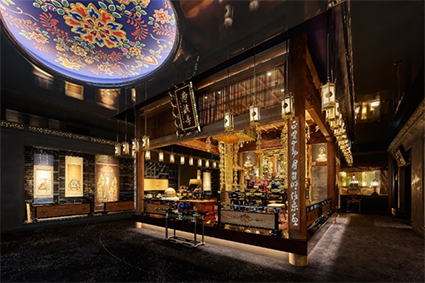
Jokyoji Temple’s main hall
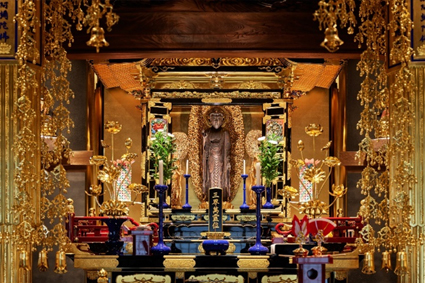
Main deity of the temple
Following the opening of the hotel, guests will have opportunities to attend a morning Buddhist prayer and to receive a red ink stamp from Jokyoji Temple’s head priest (to indicate that they have stayed there).
Comment from Koki Mitsuyama, 44th head priest of Jokyoji Temple
『A stay with the fragrance of incense that only Kyoto can offer』
The old main hall of the temple attached to the hotel, dating back approx. 190 years, has been rebuilt using the latest technologies available and traditional craftsmanship and becoming a place that provides people with intrigue and peace of mind. The inside of the temple crystallizes the magnificent, traditional and sophisticated, while items such as the principal image of Amida Nyorai, the temple’s treasure Jodo Mandala, a statue of Taira Shigemori and the historic biwa from The Tale of the Heike are blended magnificently with the modern building. The temple’s main hall is not usually opened to the public, but we invite people to take part in Buddhist trainings to enhance their ordinary lifestyles with something extraordinary. We look forward to making a valuable connection with people.
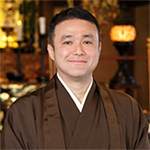
Koki Mitsuyama,
44th head priest of Jokyoji Temple
■Facility Overview of Mitsui Garden Hotel Kyoto Kawaramachi Jokyoji
| Name | Mitsui Garden Hotel Kyoto Kawaramachi Jokyoji |
|---|---|
| Location | 620 Teianmaeno-cho, Shijo-sagaru, Teramachi-dori, Shimogyo-ku, Kyoto |
| Access | Approx. 1 minute on foot from Kyoto-kawaramachi Station on the Hankyu Kyoto Main Line Approx. 7 minutes on foot from Gion-shijo Station on the Keihan Main Line |
| Structure | Partially reinforced concrete, 9 floors above ground, 1 floor below ground |
| Guestrooms | 167 |
| Adjoining Facilities | Restaurant (2F), Large bath (2F) |
| TEL | 075-354-1131 |
| Official website | https://www.gardenhotels.co.jp/kyoto-kawaramachi-jokyoji/eng/ |
| Note | All rooms are non-smoking (A smoking area will be set up in the building) |
■Map
